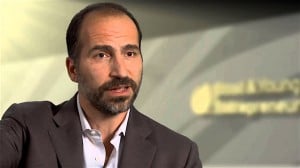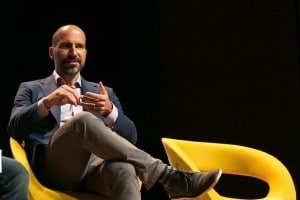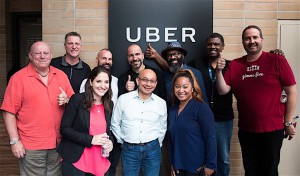It’s not been a good couple weeks for the ride-sharing industry, on the whole. Cruise Automation, the General Motors autonomous technology unit, has indefinitely delayed the launch of its self-driving service. And Lyft, the second-largest U.S. ride-share operation, lost its chief operating officer, sending its stock plunging.
But the story making the biggest headlines has been the announcement that Uber is laying off 400 people, a third of its marketing unit. Considering the way the company has been battered this year – losing more than $1 billion during the first quarter, and suffering a much weaker than expected IPO – that news is raising plenty of questions about what is going on at the ride-sharing segment leader.
Exactly what do the layoffs tell us about Uber? “There’s a general sense that while we’ve grown fast, we’ve slowed down,” CEO Dara Khosrowshahi said in a letter sent to Uber staff, though he tried to downplay that image and suggest it simply reflects the sort of moves a more mature company needs to make.
(Uber Not Likely to Be Profitable for A Few More Years)
Since it was founded, Uber has been a company big on promises but short on profits. It went $1.01 billion into the red during the January-March quarter, after reporting full-year losses of $3 billion for 2018, and $4 billion in 2017. And company officials have cautioned that they won’t be looking to deliver black ink in the near-term future, either.
“We’re certainly not measuring our success over a day, it really is over the years,” Uber CEO Khosrowshahi said after the company’s shaky IPO.
There had been big expectations in the year ahead of that long-awaited initial public offering, but doubts began to form after the lukewarm reception for rival Lyft’s own stock offering. Uber performed even more poorly, plunging almost immediately after trading began. While the stock is now up slightly from its opening day, it has had nowhere near the sort of bounce that tech companies have traditionally anticipated.
And that appears to reflect a major shift in perspective. Tech firms, like Apple and Google, were buoyed by expectations very different from the way investors have traditionally valued more conventional companies. That’s still the case with Tesla, though its recent slide in market value suggests Wall Street is now starting to think of it as a car company, rather than part of Silicon Valley. That seems to be the case with Uber, as well – complicated by questions about its fundamental business strategy.
From almost the very beginning, founder and former CEO Travis Kalanick put his own bet on autonomous vehicles that would eventually eliminate the need for Uber’s single biggest cost: its drivers. But, as it found out when a self-driving prototype struck and killed a pedestrian near Phoenix last year, that technology, almost certainly, will take a lot longer to bring to market than many had anticipated. A new J.D. Power study released Tuesday suggested it will be years before they become commonplace.
So, what to do to in the meantime? One possibility would be to raise rates.
There are now millions of Americans who have come to depend upon Uber – and competitors. But the economics aren’t always in their favor, with convenience being a balancing factor. Raise the current average $12.95 ride by 20% and you make it even less attractive, especially for those who might want to give up a personal vehicle entirely, concluded a study by Swapalease.com.
(Uber Stock Keeps Falling Even After it Stumbles Coming Out of The Gate)
If “these costs rise further, consumers will need to take a harder look when considering these options for personal transportation,” said the website’s Executive Vice President Scot Hall.
The alternative is to take a look at costs. That’s often an area tech start-ups tend to ignore until they finally have to follow more traditional business models. And, it seems, that’s something Uber CEO Khosrowshahi has in mind.
“Put simply, we need to get our edge back,” Khosrowshahi said in his e-mail. “Many of our teams are too big, which creates overlapping work, makes for unclear decision owners, and can lead to mediocre results. As a company, we can do more to keep the bar high, and expect more of ourselves and each other.”
But why the marketing department? One might think that’s a critical center for a service company. True, but Uber has become pretty much a household name – indeed, a verb – in recent years. People talk about “ubering” to their destination.
So, the initial marketing needs, establishing awareness of an unknown company, have largely been fulfilled. Uber today needs to just keep itself on the radar. And that requires a very different sort of “programmatic” marketing, much of which can be handled by handy algorithms, rather than humans staring at computer screens.
“We are not making these changes because Marketing has become less important to Uber,” the CEO explained to his staff. “The exact opposite is true: we are making these changes because presenting a powerful, unified, and dynamic vision to the world has never been more important.”
It’s highly likely that Khosrowshahi and his senior team are looking at still other ways to trim costs to sharpen the company’s edge. Even with a well-funded bank account, billion-dollar losses will eventually take their toll.
(Uber Aiming to Relaunch Autonomous Testing on Public Roads)
Uber has got to be thinking more as a conventional business, and while it can’t lose sight of its long-term goals, it has to pay a lot more attention to the short-term challenges it faces.




Marketing expense was about equal to Uber’s entire loss.
OK, some marketing is needed, but maybe not $3.2 billion per year.